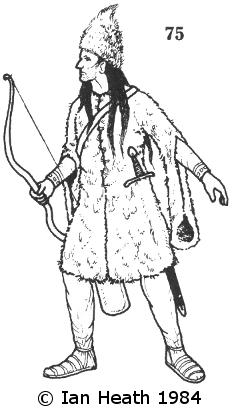ROUMANIAN FOOT-SOLDIER, 14th CENTURY
An extract from Armies of the Middle Ages, Volume 2by Ian Heath


75. ROUMANIAN FOOT-SOLDIER, 14th CENTURY
This Wallachian comes from 2 illustrations in the 'Képes Kronika' (for which see figure 85), depicting the victory of Basarab I over King Charles Robert of Hungary at Posada in 1330. There are 20 'Vlachi' portrayed in the originals, of whom 9 wear tall, grey-white sheepskin hats and 7 wear rough sheepskin coats with tubular sleeves, which had either a vent at the elbow or else a hanging flap (the latter admittedly unlikely in such a practical garment). Only 3 wear both the hat and the coat. The figure illustrated here wears his over a white tunic with embroidered cuffs, others wearing red or light green tunics. Sandals and grey or tan trousers, tight at the ankles, complete the costume. Some wear a beard and/or moustache, but this particular man is clean-shaven, and they all wear their hair very long, a Wallachian (and Moldavian) fashion confirmed by other pictorial sources such as the tombstone of Voivode Radu I (c. 1377-83) and portraits of Dracula, Basarab III Laiota and other 15th century princes. It is easy to see from his appearance why contemporaries almost invariably described Roumanian infantry as rustici or peasants. Their principal weapon was the composite bow, but others were armed with swords, spears, javelins, maces ('wooden clubs' are recorded being used at Posada), scythes, axes, flails, and some crossbows.
Doubtless the Transylvanian and Wallachian elements of Sigismund's Hungarian army at Nicopolis in 1396 included infantry of this type, since the Religieux de Saint-Denis says that Sigismund recommended the Christian attack should be led by the '40,000 infantry whom he had brought', which advice Schiltberger renders as a recommendation that the Wallachians should open the attack.